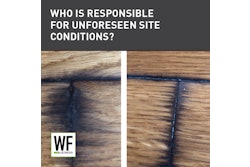Tony's crew is installing a floor for a particularly good-looking client. He's not on the site every day, but Tony heard from the guys how one of his employees, Bubba, is giving another employee, Dave, a hard time because Dave doesn't talk trash about the attractive woman like the other guys often do. Bubba has accused Dave of being "less than a man" and "girlie," and has resorted to things like planting skimpy female lingerie in Dave's lunchbox and taping naked pictures of women on the big machine. The crew thinks the ongoing jokes are funny, but Tony's not sure if these are harmless jokes or if they could be a serious problem.
What, exactly, is "sexual harassment?" What are contractors' responsibilities to protect their employees from sexual harassment on the job site? What potential liability do business owners face if their employees are sexually harassed? What can a contractor do to protect himself and his employees? The answers to these critical questions continue to evolve as the courts evaluate and refine the parameters of sexual harassment claims.
Sexual Harassment Defined
Sexual harassment claims come from laws against workplace discrimination "because of" an employee's gender found in Title VII of the Civil Rights Act of 1964. The United States Supreme Court first recognized that harassment on the job can constitute a violation of Title VII's prohibition on sex discrimination in 1986.
Historically, courts have recognized two types of sexual harassment: quid pro quo and "hostile work environment." Quid pro quo ("this for that") harassment occurs when an employee is forced to choose between suffering an employment detriment or submitting to a supervisor's demands for sexual favors, e.g., when a boss demands sexual favors in exchange for a promotion. Hostile work environment sexual harassment occurs when an employee is required to endure a work environment where unwelcome conduct based on the employee's gender—such as sexual advances, requests for sexual favors or other verbal or physical conduct—is so severe and pervasive that it interferes with the employee's work performance or creates an intimidating, hostile or offensive working environment. Harassment between individuals of the same sex can be actionable.
Homosexual employees have been unsuccessful in establishing that harassment directed at them because of their sexual preference falls within Title VII's prohibition against discrimination because of gender. Thus, while many state and local laws prohibit harassment based upon an employee's sexual preference, homosexuality is not wholly protected under Title VII. However, in a fairly recent development, claims of "gender stereotyping" have been recognized as actionable, or liable to a lawsuit. Gender stereotyping claims arise when an employee is subject to harassment or unequal treatment because the employee's conduct does not conform to established sexual stereotypes—i.e., a woman is harassed because she is not feminine enough, or a man is denied equal employment opportunities because he is not masculine enough. For instance, if one salesman brings in as much business as his colleagues, but is denied a promotion because he isn't as assertive, forceful or dominant as the employer thinks he should be as a man, then he may have a case against his employer based on gender stereotyping.
When is an Employer Liable?
When on-the-job harassment by an employee's supervisor results in an obvious employment action—such as a termination, a demotion or the denial of a promotion—the employer is strictly liable for the harassment. When a supervisor engages in inappropriate hostile or abusive behavior that creates a hostile environment, but no tangible job detriment occurs, the employer is still responsible to that employee unless he can prove 1) that he made a reasonable effort to prevent and promptly correct any sexually harassing behavior, and 2) that the employee failed to take advantage of any preventative or corrective opportunities provided by the employer to avoid harm. In Tony's case, if he has a welldrafted sexual harassment policy that clearly explains to employees that they should report any sexually harassing conduct and that they will be protected from retaliation if they do so, and if Dave is fully aware of the policy, Dave has an obligation to report the conduct. If Dave fails to do so, he has not taken advantage of the employer's efforts to prevent sexually harassing behavior. Furthermore, if Tony learns of the situation through another source and attempts to correct the situation by talking to Dave and offering to move Bubba to another crew, and Dave refuses the offer of assistance, then Tony would have a good defense should Dave subsequently complain of harassment. However, if Tony knew about the harassment and didn't take any action to ensure Dave's safety, then he may be liable to Dave if the situation rises to the level of a hostile work environment.
When the harasser is not a supervisor, but a co-worker or a non-employee, such as a vendor or a client, there is an additional element to the employee's claim. For an employer to be liable for the sexually harassing acts of a co-worker or non-employee, the victim must establish that the employer knew or should have known about the conduct and failed to take immediate and appropriate corrective action.
Protective Steps
What should an employer do to protect its employees from sexual harassment and to protect himself from liability for sexual harassment claims?
1) Establish a policy.
The first and most important step for every employer is to establish a strong, effective policy prohibiting sexual harassment in the workplace. In establishing the policy, the employer should focus on preventing harassment and encouraging employees to report incidents of harassing behavior as soon as they take place. The policy should contain the following elements:
• A description of what constitutes prohibited sexual harassment.
• A statement that harassment will not be tolerated and that appropriate disciplinary action will be taken against employees who engage in sexually harassing behavior.
• A reporting procedure for all employees who believe they have been subject to harassment, or who have witnessed the sexual harassment of others.
There should be strong encouragement to report the behavior. The reporting policy must identify at least two individuals to whom the employee can report harassment and allow the employee to bypass his or her supervisor if the supervisor is the harasser.
• Give notice that complaints will be handled sensitively and promptly and that employees who lodge complaints will be protected from retaliation.
2) Investigate all complaints of sexual harassment.
Because employers are protected from liability only if they take prompt and reasonable steps to correct sexual harassment when they learn of it, every claim of sexual harassment should be taken seriously. The reporting employee should be encouraged to state the complaint in writing, including as many details as possible and any witnesses to the harassment. The employee's written statement can provide the basis for the employer's good faith investigation into the allegations. Because investigation notes and reports will certainly be an exhibit in any trial involving a sexual harassment claim, the employer should contact a lawyer before investigating the complaint. When the investigation is completed the employer must—preferably with the assistance of a lawyer— decide the appropriate steps to take, including disciplinary action against the harasser if the claims of harassment are substantiated.
3) Conduct annual training on the company's anti-harassment policy.
The best anti-harassment policy in the world will provide no protection to an employer or its employees if the employees do not know of its existence and its specific terms. To prevent this from occurring, the employer should conduct annual training programs in which all employees are educated regarding the policy's terms and sign off that they acknowledge receipt of the policy.
4) Train supervisors.
Immediate supervisors are often the first people to receive reports of sexual harassment. Therefore, supervisors must be trained to immediately report any such complaints to the appropriate person—whomever the designated company official may be. Frequently, sexual harassment victims complain but say that they don't want the supervisor to tell anyone or take any formal action. Supervisors must be informed that the employer has a duty to investigate all complaints of sexual harassment—even if the complainant has requested confidentiality. Once the employer knows of the harassing behavior, he has an absolute duty to prevent any further harm.
While sexual harassment, unfortunately, remains a reality in today's workplace, there are steps that all employers can take to protect their employees and to protect themselves from liability. Because of the sensitive nature of these situations, and because the law of sexual harassment is constantly evolving, consult your lawyer to make sure that you have taken all appropriate preventative measures.
































